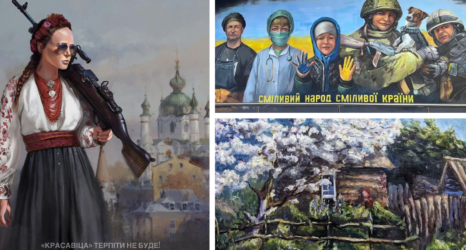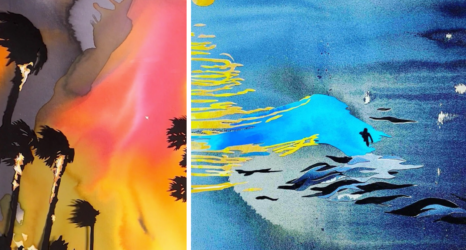Of the crop of stellar illustrators America produced during the culture-rocking early 1960s, few have been more notable, enduring and, I would say, magnificent than Barbara Nessim, whose work–though often commissioned for magazines, posters and ads–can as easily be considered art with a capital A. But Nessim, a woman from the Bronx whose talent burst forth at any early age, is far too unpretentious to insist on that label.
A retrospective of Nessim’s career, originally curated by the Victoria and Albert Museum in London, is currently on view at the Bard College Graduate Center’s three-floor townhouse gallery on 18 West 86 St. until January 11. To anyone living in or near Manhattan I say: Don’t miss it! The exhibit not only traces the career of this profound, provocative and witty depictor of American women in a comprehensive and intimate way, it is also a cultural journey of over 50-plus years.
Furthermore, it’s a chance to see work by an illustrator who was one of the first to make a splash in the pages of Ms. magazine (see image at top of page). Nessim knew Ms.‘s first art director, the brilliant Bea Feitler, and had worked with her at Glamour magazine–and she also was quite familiar with Ms. cofounder Gloria Steinem, who she roomed with from 1962-1967. “I would say because my work was (naturally) woman-centric, I was a perfect choice [for Ms.] to use as an illustrator,” says Nessim.
I had the pleasure of being guided through the exhibit by the artist, who I had interviewed in 2009 for a profile I was writing on her other roommate from the 1960s, actor Ali MacGraw. Barbara, Ali and Gloria: Talk about three iconic and dazzling young women, on the brink of both reflecting and changing society, each in her own way.
Here are some highlights of my personal tour, from notes I scribbled as we walked:
“I invented monotype etching,” Barbara says, as we view eight images from her series of early ‘60s etchings, “Man and Machine.” Etching in various colors used to be a tremendously laborious chore; when the young Nessim suggested to her instructor at the Pratt Institute that she could do it in one step, he said, “That’s not allowed!” She riposted, “Where are the rules?” The hues in the images made from her new method have remained brilliant to this day.
(Barbara wasn’t the only female illustrator-inventer of the time. Her good friend Shirley Glaser came up with New York’s very first group “themed” gallery show in 1964.)
In the early ‘60s, when Barbara shared a small studio with five other artists (all guys), “The only people who would hire me were girly magazines–the poor man’s Playboy.” This was true for most scraping-by illustrators, the overwhelming majority of them male. “I was one of two women–the other one was Lorraine Fox, who was ten years older than me.” For a magazine called Nugget, in 1964, Nessim illustrated Terry Southern’s story “Candy,” about a naïve, sexually-hit-upon 18 year old: a story that expressed older men’s fantasies with a touch of the probing self-liberation (often met with exploitation, if not danger) that adventurous girls struggled with during the era. Barbara’s illustration made Candy not a strumpet but charming and human, with–presciently anticipating the Age of Aquarius–flowers in her hair. Still, hairy man’s hands grasped Candy’s bare breasts; freedom from indignity was a long way away. But ownership of her sexuality was not: Barbara sketched a sly, secret touch. Candy is wearing, around her neck, a necklace that (if you look hard at it), depicts a couple making love.
Another drawing from her sketchbook from this time is a pen and ink sketch of a naked woman wearing glasses. She is looking at a clothed man’s face. He is also wearing glasses, but he is looking not at her, but, rather, out at the world. The vulnerable and deferential female versus armored and assertive male. “Who knew this was a feminist?” Nessim says, in wonderment. The emerging movement was coming out, through her art.
In her “Woman Thinking Blue at a Party” (1966), Barbara cleverly etched in a barely visible Rudi Gernreich swimsuit on the woman, signaling a new age for fashion. A year later, “all my friends who were married were getting divorced,” she says. “I had lots of boyfriends but I was smart. I didn’t marry until I was 41.”
Barbara was ahead of the times in putting a rainbow motif in many of her personal drawings. Her good friend Milton Glaser, Shirley’s husband, saw it and–in a probable display of subconscious influence–he came up with his massively famous rainbow’d Bob Dylan poster a few months later. Barbara says she didn’t mind, and she doesn’t consider this to have been an unfair appropriation: The Glasers were such close friends, she spent almost every weekend together in Woodstock with them. Sharing ideas was part of the creative life of intimate colleagues.
Barbara’s illustrations became part of the music world. She was asked to do a Rolling Stone cover of John Lennon in 1988, eight years after his assassination. It is haunting: a half-face for a half-completed life, “red for the violence, blue because he’s in the cosmos.” The famously specific Yoko Ono, Lennon’s widow, had to approve it. She instantly did.
Her WomanGirl series (1972-73) is most arresting: semi-nude women on ballet toe shoes (the en pointe illustrating “the perfection” expected of women), with full, pert breasts, no pubic hair and chastity belts. Except the chastity belts are open, not locked. WomanGirl symbolized the complexity and challenges of being young and female in a half-changed world. Given the strict “public decency” laws at the time, because the WomanGirls were so unclothed, “I could have been arrested back then for exhibiting them,” Nessim recalls. She worried that police officers might crash her SoHo gallery show opening.
In 1982, when the ERA failed to be ratified in three states, Barbara did an illustration for the cover of TIME of a large woman’s head, tilted down, looking sad but not angry. The head was drawn over an ascending staircase-like line; above was a field of black, below a field of white, representing all women, black and white, and every color in between. At the bottom of the staircase, in the black field (“she is still in the dark”) stands a red silhouette of a tiny resolute woman, looking up at the long steep flight of stairs. “She is climbing. She will make it,” Barbara insists.
That same year Barbara became one of the first illustrators to work on computers. After a learning session at MIT, “it took me two years to find a computer in New York,” and, at that, it was “a secret one” stealthily provided by Time, Inc. Video Information Services. One of her computer-imaged pieces is of a massive, almost wall-sized Union Jack, with 200 separate line drawings superimposed over it. It’ a powerful work, and the fact that you have to stand and ferret out every separate image makes it slow-going in a way that fosters gravity and thoughtfulness. “The painting is about migration, population growth, diversity,” she says, and she may as well be talking about today.
Barbara is the daughter of Sephardic Jews who had migrated from Turkey and Egypt, her mother (and creative inspiration) working as a blouse designer in an unregulated factory. The daughter became one of the very few young women to illustrate an Eisenhower-era America that was just starting to crumble. She drew and sketched and etched and painted the crumbling culture, and then the triumph and setbacks and glory and colorful noise along the way to a new culture and her own uncompromised career.
That’s why it’s worth seeing Barbara Nessim’s retrospective–it’s art as history and life lesson.
The original Victoria and Albert exhibit is catalogued in Barbara Nessim: An Arftul Life.
Images courtesy of Barbara Nessim.





